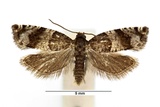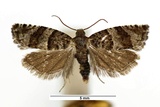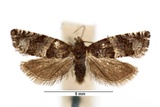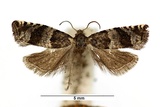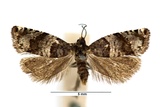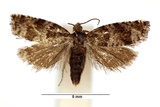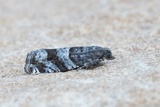Rhopobota myrtillana (Humphreys & Westwood, 1845) Species
Last modified: May 30, 2024, 5:30 p.m.
A very rare species in Belgium.
Details
- Classification
- Family: Tortricidae > Subfamily: Olethreutinae > Tribus: Eucosmini > Genus: Rhopobota > Species: Rhopobota myrtillana
- Vernacular names
- Bosbesbladroller (NL), Bilberry Bell (EN)
- Synonyms
- Rhopobota vacciniana (Lienig & Zeller, 1846)
- First mention in Belgium
- De Sélys-Longchamps E. 1844. Énumération des insectes Lépidoptères de la Belgique. — Mémoires de la Société royale des Sciences de Liége 2: 1–35. On page 22.
- Status
-
Native
Distribution
Imago
Wingspan 9–12 mm. Reddish-brown forewings with grey basal field. White cross bands 1/3 out and from the back corner towards 2/3 out. Both bands are angled inwards towards the leading edge. Dark brown uniform narrow spot from termen to costa and apical spot in the same shade.
Caterpillar
The caterpillar is grey-green to light yellow-brown, the head and neck shield are black, the anal valve is pale yellowish.
Mine
See also bladmineerders.be
Tiny full depth blotch or broad corridor, practically without frass.
Bionomics
The larvae soon leave their mines, and continue feeding at first in a web, later in the upper leaves that are spun together, from which it eats the epidermis. Pupation between fallen leaves on the ground.
The moths can be seen in the late afternoon and early evening sunshine, in flight over its foodplant. Later the adults come to light.
Flight periods
The adults can be observed from mid-April towards late June.
Observed on
- Host plant (species):
- Vaccinium myrtillus
The larva feeds mainly on Vaccinium like Vaccinium myrtillus, Vaccinium uliginosum, Vaccinium vitis-idaea. Also on Andromeda polifolia, Rhododendron tomentosum and Berberis vulgaris.
Habitat
It inhabits moorland and heathland in areas where bilberry is present.
